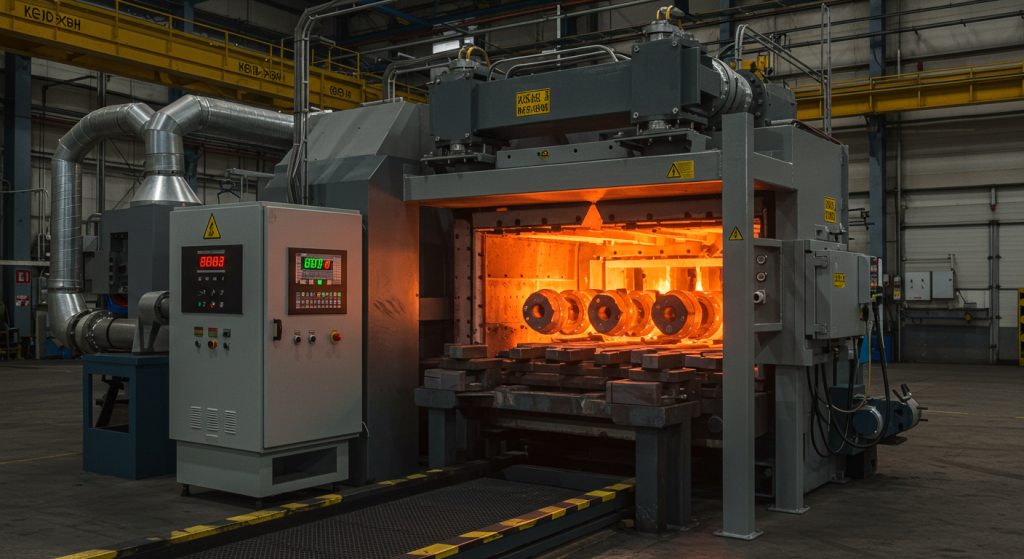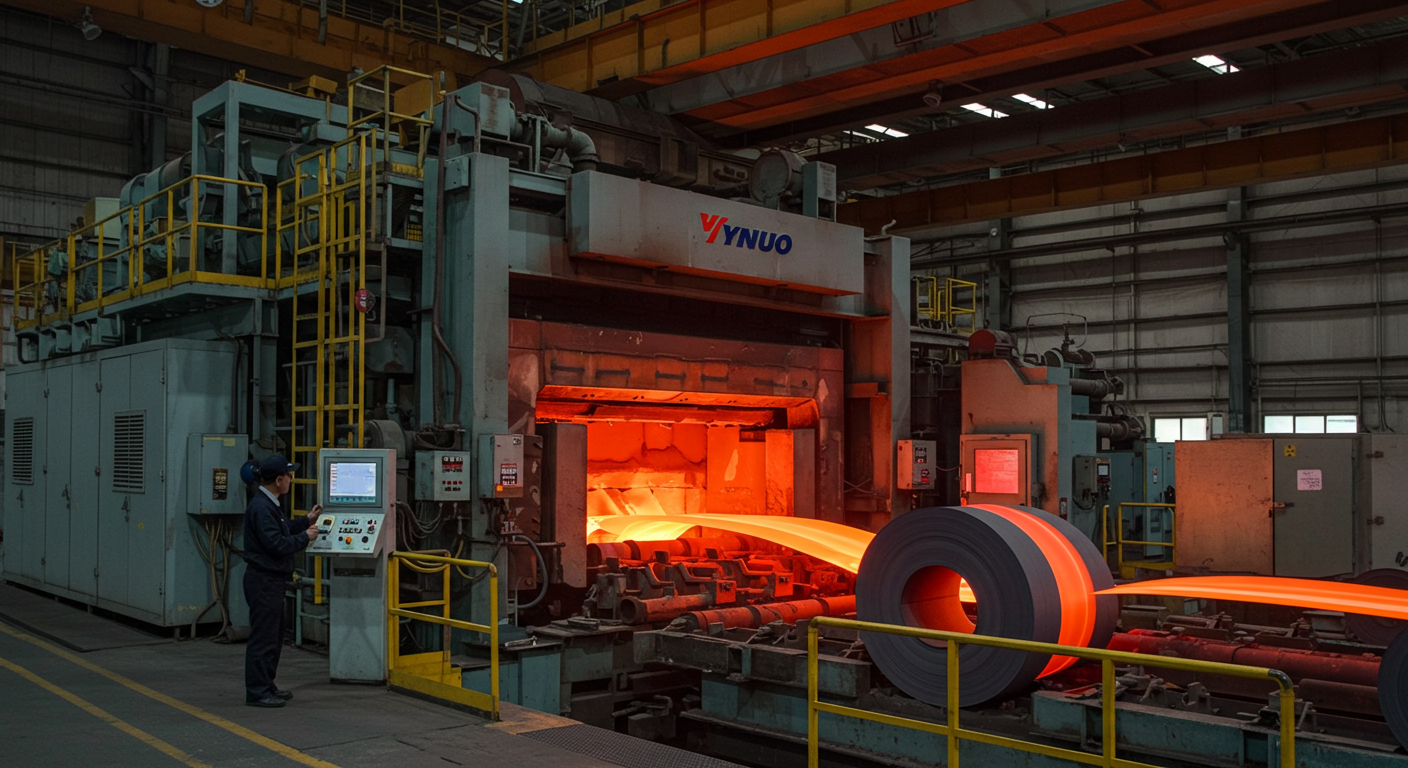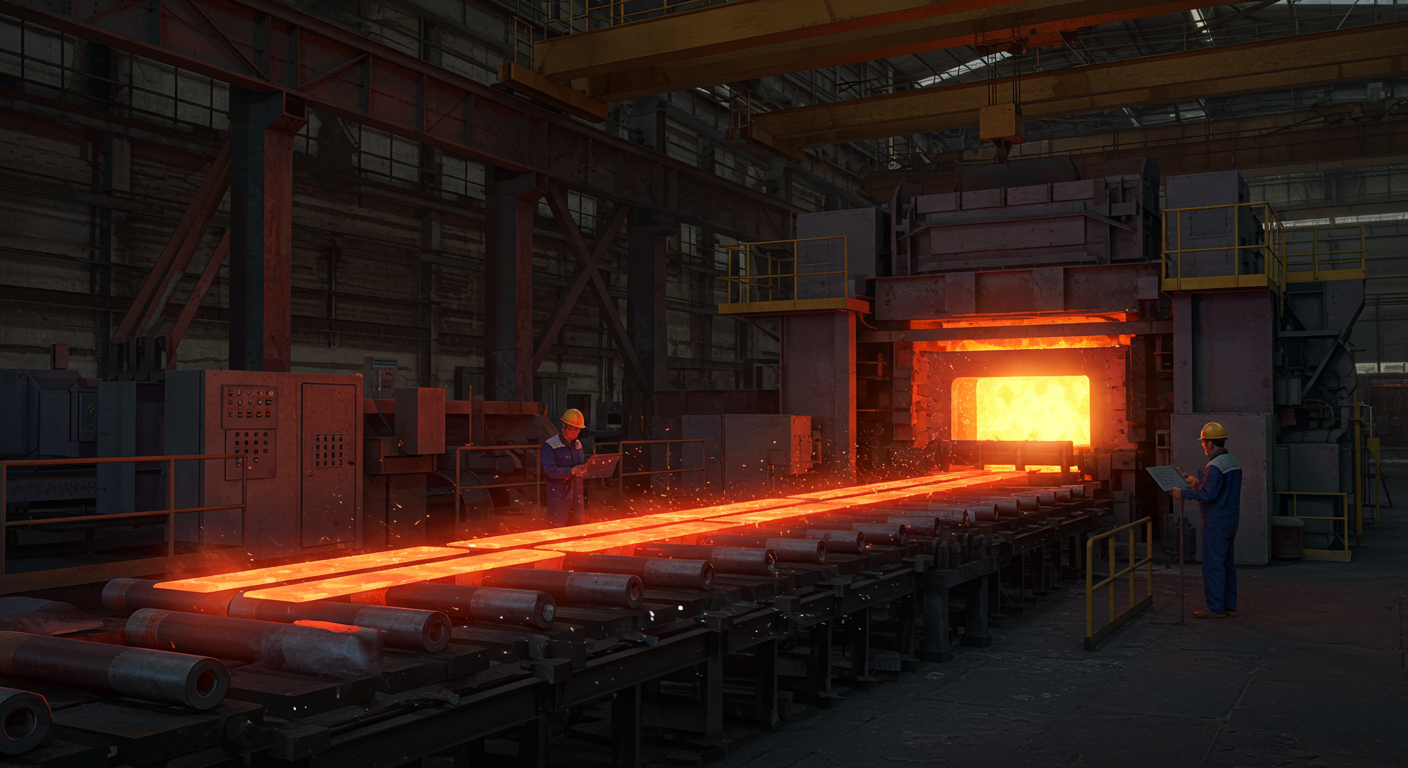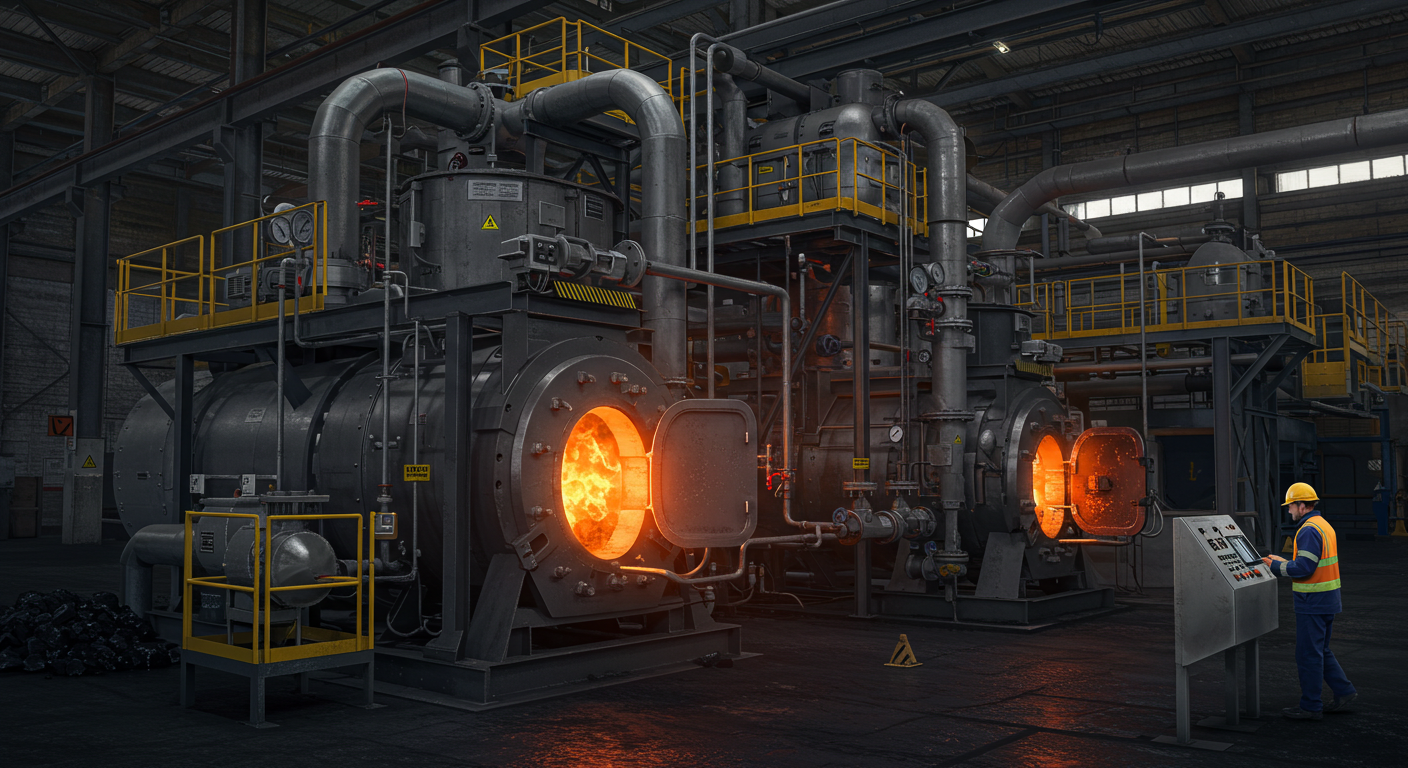
Thermal annealing furnaces are specialized systems designed to heat treat materials, primarily metals, glass, and polymers, by heating them above their recrystallization temperature and cooling them at a controlled rate to enhance ductility, reduce hardness, and relieve internal stresses. These furnaces are vital in industries such as electronics, aerospace, and manufacturing, where material properties directly impact performance. Jiangsu Yinuo Thermal Energy Technology Co., Ltd., based in Xuzhou, China, stands as a global leader in manufacturing advanced thermal annealing furnace solutions. This guide explores the technology, applications, and benefits of thermal annealing furnaces, detailing their role in modern industrial processing, with a focus on precision, versatility, and sustainability.
Understanding Thermal Annealing Furnace Technology
Thermal annealing furnaces heat materials to specific temperatures, typically between 500°C and 1200°C, depending on the material, to alter their microstructure and mechanical properties. The design prioritizes uniform temperature distribution, controlled cooling, and compatibility with diverse materials, ensuring consistent outcomes in processes like recrystallization and stress relief. Advanced features, such as vacuum or controlled atmosphere systems, enhance performance, making these furnaces essential for both small-scale and high-volume production.
Core Components
A thermal annealing furnace features a heating chamber constructed with refractory materials, such as high-alumina bricks or ceramic fiber insulation, to withstand extreme temperatures. Temperature control systems employ PID controllers or PLC-based automation for precise thermal regulation across multiple zones. Heating is provided by gas-fired burners, often with regenerative capabilities, or electric elements like silicon carbide or molybdenum disilicide for high-temperature applications. Atmosphere control systems, using inert gases like nitrogen or hydrogen, prevent oxidation, while material handling mechanisms, such as conveyor belts or roller hearths, facilitate continuous or batch processing. Cooling systems, including air jets or quenching tanks, ensure controlled cooling rates.
Operational Mechanism
Materials enter the furnace via a loading system, progressing through preheating, heating, and soaking stages. The preheating stage gradually raises temperatures to 300–600°C, minimizing thermal shock. The heating stage elevates materials to their recrystallization temperature, typically 700–1200°C, promoting atomic diffusion and stress relief. The soaking stage maintains this temperature to ensure uniform microstructure changes. Controlled cooling, either within the furnace or through external quenching, completes the process, forming ductile grains. Automation ensures precise temperature and atmosphere management, optimizing repeatability and quality.
Key Applications of Thermal Annealing Furnaces
Thermal annealing furnaces serve a wide range of industries, enabling precise heat treatment for materials requiring enhanced workability and performance. Their versatility makes them suitable for processing metals, glass, and polymers in various forms, from wires to large sheets.
Electronics and Semiconductor Manufacturing
In electronics, thermal annealing furnaces anneal semiconductor wafers to activate dopants, repair implantation damage, or densify deposited films, improving electrical properties. Vacuum or inert atmosphere furnaces ensure contamination-free processing, critical for silicon and gallium arsenide wafers. Rapid thermal annealing (RTA) variants, with cycles lasting minutes, minimize dopant diffusion, supporting high-precision applications in microchip production.
Aerospace and Alloy Processing
Aerospace applications involve annealing high-performance alloys, such as titanium and nickel-based superalloys, to enhance ductility and toughness for components like turbine blades. Protective atmospheres and tight temperature tolerances (±5°C) prevent oxidation and ensure compliance with aerospace standards, such as AMS 2750, delivering reliable material properties for safety-critical parts.
Automotive Component Production
Automotive manufacturing uses thermal annealing furnaces to process steel and aluminum for body panels, gears, and suspension components. Subcritical or full annealing softens high-strength steels, improving formability for complex shapes. Continuous furnaces, like conveyor belt or roller hearth systems, support high-volume production, ensuring consistent quality for automotive safety standards.
Glass and Polymer Processing
In glass manufacturing, thermal annealing furnaces relieve internal stresses in products like optical lenses or architectural panels, preventing cracking. Polymer annealing enhances the crystallinity of plastics, improving strength for medical devices or packaging. Low-temperature furnaces (100–300°C) with precise cooling rates ensure optimal material properties for non-metallic applications.
Benefits of Thermal Annealing Furnaces
Thermal annealing furnaces offer significant advantages, addressing the needs of industries seeking material quality, process efficiency, and environmental responsibility. Their advanced technology ensures high performance in diverse manufacturing settings.
Enhanced Material Properties
Annealing reduces hardness and internal stresses, increasing ductility and machinability, as atoms redistribute within the crystal lattice, reducing dislocations. This results in materials that are easier to shape, less prone to cracking, and suitable for further processing, critical for industries like electronics and aerospace.
Energy Efficiency
Regenerative burner systems recover up to 85–90% of waste heat, reducing fuel consumption by 30–50%. Ceramic fiber insulation minimizes heat loss, lowering energy costs. Electric heating options achieve near-100% thermal efficiency, compared to 30–40% for gas systems, aligning with sustainability goals and reducing operational expenses.
Versatility and Scalability
Furnaces accommodate a wide range of materials, from ferrous and non-ferrous metals to glass and polymers, with customizable thermal cycles. Configurations like batch or continuous systems support small-scale laboratories or large-scale production, offering flexibility for diverse industrial needs.
Comparison Table: Thermal Annealing Furnaces vs. Other Annealing Furnace Types
| Feature | Thermal Annealing Furnace | Vacuum Annealing Furnace | Continuous Conveyor Furnace | Batch Annealing Furnace |
|---|---|---|---|---|
| Operation Type | Continuous or batch, versatile for metals/glass/polymers. | Batch, vacuum for contamination-free processing. | Continuous, high-throughput for mass production. | Batch, low-volume, flexible processes. |
| Temperature Range | 500–1200°C, material-specific. | 500–1000°C, precision-focused. | 500–1100°C, suited for steel. | 500–1200°C, varies by process. |
| Energy Efficiency | High (regenerative burners, insulation, 30–50% savings). | Moderate (vacuum systems consume more energy). | High (continuous operation, efficient). | Lower (no continuous heat recovery). |
| Atmosphere Control | Nitrogen/hydrogen, prevents oxidation. | Vacuum, eliminates contamination. | Nitrogen, some oxidation risk. | Varies, often less controlled. |
| Applications | Electronics, aerospace, automotive, glass/polymers. | Semiconductors, aerospace alloys. | Steel sheets, automotive parts. | Small parts, specialty alloys. |
| Production Scale | Small to large-scale, adaptable. | Small-scale, high-precision. | Large-scale, high-volume. | Small-scale, custom production. |
| Maintenance | Moderate, IoT predictive tools. | Higher, vacuum system complexity. | Moderate, conveyor maintenance. | Lower, simpler design. |
| Cost Efficiency | High, due to energy savings and versatility. | Moderate, higher setup costs. | High, efficient for large volumes. | Lower, but limited throughput. |
Technical Advantages of Thermal Annealing Furnaces
Thermal annealing furnaces incorporate advanced features that enhance operational efficiency, material quality, and sustainability, addressing the challenges of industrial heat treatment.
Advanced Heating Systems
Regenerative burners cycle between firing and exhaust, recovering waste heat to preheat combustion air, reducing fuel use by up to 50%. Low-NOx designs minimize emissions, complying with regulations. Electric elements, such as silicon carbide or molybdenum disilicide, offer precise heating for high-temperature annealing, ensuring clean operation for sensitive materials like semiconductors.
Atmosphere Management
Protective atmospheres, such as nitrogen-hydrogen blends or vacuum environments, prevent oxidation and decarburization, critical for stainless steel or titanium. Gas-tight casings and automated atmosphere monitoring maintain precise gas compositions, ensuring clean surfaces and consistent material properties, as required in aerospace and electronics.
Precision Control and Automation
PLC-based control systems with IoT integration enable real-time monitoring, temperature adjustments, and predictive maintenance. Multi-zone heating with independent controls ensures uniform thermal profiles, supporting complex annealing cycles like intercritical or full annealing. Automated material handling reduces labor costs and enhances repeatability.
Industry-Specific Considerations
Different industries require tailored thermal annealing furnace configurations to meet specific process and material demands, ensuring optimal performance and cost efficiency.
Electronics and Semiconductors
Electronics applications demand vacuum or inert atmosphere furnaces to prevent contamination during wafer annealing. Rapid thermal annealing (RTA) systems, with cycles of seconds to minutes, minimize dopant diffusion, as noted in semiconductor fabrication studies, supporting high-precision microchip production.
Aerospace and High-Performance Alloys
Aerospace requires furnaces with hydrogen atmospheres and tight tolerances (±5°C) for annealing titanium or nickel alloys. Rapid quenching systems ensure precise cooling rates, maintaining material properties for safety-critical components like turbine blades, meeting standards like AMS 2750.
Automotive Component Production
Automotive applications use continuous furnaces for high-volume annealing of steel sheets or components. Conveyor belt or roller hearth systems handle large batches, while regenerative burners reduce costs, supporting the production of lightweight, high-strength parts for fuel efficiency.
Glass and Polymer Industries
Glass and polymer annealing requires low-temperature furnaces (100–600°C) with controlled cooling to prevent stress-induced cracking. Convection systems ensure uniform heat distribution, critical for optical glass or medical-grade plastics, enhancing durability and clarity.
Challenges and Solutions
Thermal annealing furnaces face challenges like energy consumption, material quality control, and maintenance demands, but advanced engineering addresses these issues effectively.
Energy Consumption
High-temperature annealing consumes significant energy. Regenerative burners and ceramic fiber insulation reduce losses by up to 50%. Electric furnaces with high-efficiency elements minimize energy use, particularly for small-scale applications, as seen in semiconductor processing.
Material Quality Control
Non-uniform heating or scaling can cause defects. Multi-zone temperature control and protective atmospheres ensure uniform heating and clean surfaces. Automated monitoring systems prevent atmosphere leaks, critical for high-quality annealing of sensitive materials.
Maintenance and Downtime
High temperatures stress furnace components. Robust refractories and modular designs extend lifespan. IoT-enabled predictive maintenance and spare parts bundling reduce downtime, ensuring continuous operation in high-throughput environments.
Future Trends in Thermal Annealing Furnaces
The thermal annealing furnace industry is evolving, driven by advancements in automation, sustainability, and material processing, shaping the future of industrial heat treatment.
Automation and Smart Technology
AI-driven controls and IoT integration enable real-time optimization, predictive maintenance, and material tracking. Automated systems reduce labor costs and enhance precision, supporting complex annealing processes for advanced materials, driving productivity in high-volume manufacturing.
Sustainability Initiatives
Electric furnaces and renewable energy integration lower carbon emissions, aligning with environmental regulations. Ultra-low NOx regenerative burners and advanced insulation further reduce environmental impact. These trends support sustainable material processing, meeting global demand for greener production.
Advanced Material Processing
Demand for furnaces supporting high-performance alloys, semiconductors, and polymers is rising. Furnaces are adapting to process materials like gallium arsenide or high-strength steels, requiring precise thermal cycles, supporting innovation in electronics and aerospace.
Choosing a Thermal Annealing Furnace
Selecting a thermal annealing furnace requires evaluating process, material, and production needs to ensure optimal performance and cost efficiency.
Key Considerations
Material type, such as steel, glass, or polymers, determines furnace configuration and atmosphere requirements. Process needs—full annealing, stress relief, or RTA—dictate temperature range and cooling system. Production scale influences furnace size, with continuous systems suiting high-volume production. Energy efficiency, driven by regenerative burners or electric systems, impacts costs. Automation and maintenance support ensure reliability.
Partnering with Jiangsu Yinuo
Jiangsu Yinuo’s team provides expert guidance, designing custom furnaces tailored to industrial goals. Installation and ongoing support ensure seamless performance, delivering precision and efficiency. Clients can explore solutions and connect through the Jiangsu Yinuo website for tailored furnace options, backed by global expertise.
FAQ
What is the purpose of a thermal annealing furnace?
Thermal annealing furnaces heat treat materials to enhance ductility, reduce hardness, and relieve stresses, improving workability for industrial applications.
What materials can thermal annealing furnaces process?
Steel, aluminum, titanium, copper alloys, glass, and polymers are processed, supporting electronics, aerospace, and automotive industries.
How is furnace quality ensured?
Production involves rigorous testing of components, using premium refractories, with compliance documentation meeting ISO and CE standards.
Are thermal annealing furnaces customizable?
Furnaces are tailored to specific material, process, and production needs, with support from design to installation.
How energy-efficient are thermal annealing furnaces?
Regenerative burners and insulation reduce fuel use by up to 50%, lowering costs and emissions.
How can a quote be requested from Jiangsu Yinuo?
A contact form, email, or phone inquiry through the Jiangsu Yinuo website provides a prompt response.
Conclusion
Thermal annealing furnaces deliver precision, efficiency, and sustainability, driving high-quality material processing in electronics, aerospace, and automotive industries. Jiangsu Yinuo Thermal Energy Technology Co., Ltd. offers innovative, customized solutions that empower manufacturers globally. With advanced technology and a focus on performance, these furnaces meet the demands of modern heat treatment. Explore solutions and connect through the website for a tailored quote to enhance production capabilities today.







